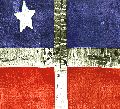Mariana Bracetti facts for kids
Quick facts for kids
Mariana Bracety Cuevas
|
|
|---|---|

"Brazo de Oro"
(Golden Arm) |
|
| Born | July 26, 1825 |
| Died | February 25, 1903 (age 77) |
| Occupation | Puerto Rico independence movement leader |
| Spouse(s) | Miguel Rojas |
Mariana Bracetti Cuevas (also spelled Bracety) was an important leader in Puerto Rico's fight for freedom from Spain in the 1860s. She was born on July 26, 1825, and passed away on February 25, 1903. Mariana is famous for knitting the very first flag meant to be the national symbol of Puerto Rico. This flag was created for a planned uprising against the Spanish government, known as the Grito de Lares. Her flag became known as "The Flag of Lares" and is now the official flag of the town of Lares, Puerto Rico.
Contents
Growing Up in Puerto Rico
Mariana Bracetti was born in Añasco, Puerto Rico. She met Miguel Rojas Luzardo, a wealthy businessman from Venezuela. Miguel and his brother, Manuel, owned a coffee farm called "El Triunfo" near the town of Lares.
The Rojas brothers greatly admired Dr. Ramón Emeterio Betances. He was a leader who believed Puerto Rico should be free from Spanish rule. Mariana married Miguel Rojas and they had children together.
Designing the First Independence Flag
Mariana moved to the "El Triunfo" farm, which became a secret meeting place for those planning the revolution. The Rojas brothers joined Dr. Betances in their plan to gain independence from Spain.
The Rojas brothers became key leaders in Lares. Their secret group was called Centro Bravo (Bravo Center). Manuel Rojas, Mariana's brother-in-law, was chosen to lead the Liberation Army.
Mariana Bracetti was known by the nickname Brazo de Oro (Golden Arm). She was put in charge of the "Lares's Revolutionary Council." Dr. Betances asked Mariana to knit the first flag for the future "Republic of Puerto Rico." He gave her ideas for the design.
Eduvigis Beauchamp Sterling, who was the revolution's Treasurer, provided the materials. Mariana designed and knitted the flag based on Betances's suggestions. The flag had a white cross in the middle. The two bottom corners were red, and the two top corners were blue. A white star was placed in the top left blue corner.
According to a Puerto Rican poet named Luis Lloréns Torres, the white cross on the flag meant a strong desire for their homeland to be free. The red squares stood for the blood shed by the heroes of the rebellion. The white star in the blue square represented liberty and freedom.
The Grito de Lares Uprising
On the morning of September 23, 1868, about 800 men gathered at the El Triunfo farm. Manuel Rojas led them to take over the town of Lares. This event started the revolution known as El Grito de Lares (The Cry of Lares).
Once they took the town, Mariana Bracetti's flag was placed on the main altar of the local church. The revolutionaries declared Puerto Rico a republic. They swore in Francisco Ramírez Medina as its first president and held a quick church service.
The rebel forces then tried to take the next town, San Sebastián del Pepino. However, the Spanish army was ready and fought back strongly. This caused confusion among the rebels, who retreated back to Lares.
The governor, Julián Pavía, ordered the Spanish army to round up the rebels. All the survivors, including Mariana Bracetti, were put in jail in Arecibo. The uprising quickly ended.
The original Lares flag was taken by a Spanish officer as a war trophy. Many years later, it was returned to the people of Puerto Rico. Today, you can see it at the University of Puerto Rico's Museum.
Sadly, eighty of the prisoners died in jail. However, Mariana Bracetti survived. She was released on January 20, 1869, when the new Spanish government gave everyone involved in the uprising a pardon. Mariana Bracetti passed away in Añasco, Puerto Rico, in 1903. She was buried in the Plaza of Añasco, where a monument honors her.
Mariana Bracetti's Legacy
Juan de Mata Terreforte, a revolutionary who fought with Manuel Rojas in the Grito de Lares, later became the Vice-President of the Puerto Rican Revolutionary Committee in New York City. He adopted Mariana Bracetti's "Flag of Lares" as the flag for Puerto Rico. It was used until 1892, when a new design, similar to the Cuban flag, was created and adopted.
Mariana Bracetti is the main subject of two books: El Grito de Lares by Luis Lloréns Torres and Brazo de Oro by Cesáreo Rosa-Nieves. Many schools, streets, and avenues in Puerto Rico and other places are named after her. In Lares, there is a Mariana Bracetti Museum. In Philadelphia, there is a Mariana Bracetti Academy Charter School. The Mariana Bracetti Plaza and a public housing complex in New York City's Lower East Side are also named in her honor.
Images for kids
-
Statue of Mariana Bracety Cuevas in Añasco barrio-pueblo
See also
- History of women in Puerto Rico
- Grito de Lares
 In Spanish: Mariana Bracetti para niños
In Spanish: Mariana Bracetti para niños




